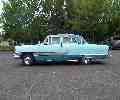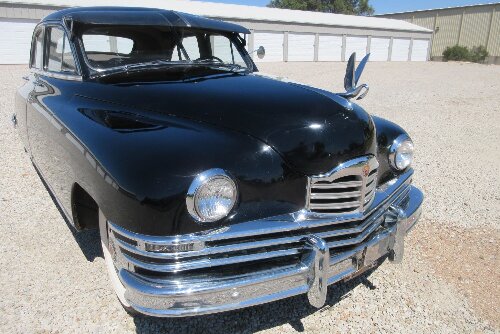|
Re: 1950 Packard 288 Auto overheating HELP
|
||||
|---|---|---|---|---|
|
Forum Ambassador

|
What is the distance between the leading (forward) edge of the fan blade and the radiator core? Is it the same top-to-bottom, left-to-right?
Posted on: 2011/2/17 9:20
|
|||
|
||||
|
Re: 1950 Packard 288 Auto overheating HELP
|
||||
|---|---|---|---|---|
|
Home away from home

|
Dear otgdy:
Timing marks can be real hard on these Packards. Especially when the damper is rusted or someone sandblasted the poor thing. Get the motor near TDC. If you see any marks then carefully take the paint off the damper. Then paint the degree you need. If the marks are obliterated that is a problem. Get another damper. They can be put on using a degree wheel given the head is off. Is this car only overheating when idling or is it running hot on the road? I had a modern Dodge that started overheating at idle when it got old. Even with a new radiator. I think the cast iron was just plain oxidized. I think Dave's story about a hot idling 288 is instructive. One thing people don't realize is that the fan actually restricts flow at high speed. I assume your car has the splash aprons on it. It think they are supposed to help flow. The radiator temperature difference from top to bottom should be very substantial. If you have the front pan off then you should be able to lay your palm on the bottom when the top is too hot to touch. If the top and bottom are warming up at the same rate then you have a flow problem. Take it to a shop and have them pull both tanks. Maybe a mouse got it.
Posted on: 2011/2/17 19:55
|
|||
|
||||
|
Re: 1950 Packard 288 Auto overheating HELP
|
||||
|---|---|---|---|---|
|
Just can't stay away

|
Owen, I will take the measurements again. Sure I did it earlier and it was to spec. Didn't check left/right measurements. What do you think about me building a cowl for the engine side of the radiator? Anyone do this on this model ?
Tim, After getting TDC how do you determine where the actual timing mark goes ? Don't remember the timing being at TDC. Hoping the mark is the real one at whatever degree BTC. Checking radiator temp drop with your hand. Doesn't the '50 flow from bottom to top making the top cooler? To check the temp with my hand I would have to take the front shroud off, wouldn't that affect the temp? No way am I going to put my hand on the radiator on the fan side. They would have to call me stumpy if I did. Still looking into new pulleys and playing the waterpump rpm game. The slow flow in idle really has me bugged. Yes all of the splash aprons shrouds etc are installed. The car ran great from Baltimore to the Bay bridge no problems.. temp normal.. running around 75 mph. Life was good. Stopped at the tolls on the bridge 5 cars in front. Overheated within minutes. Guage totally spiked. Based on later tests engine temp was easily 300+ degrees. Drove it over the bridge (approx 4miles) before temp went back to "normal" range. No it didn't boil over.. go figure ! If you are thinking continuing to drive it was a stupid move. Your probably right. Wasn't going to foot the bill for a tow off the bridge which is substantial. In the time I have been messing with this car. I totally restored (rebuilt powertrains,interiors,suspensions,paint) a '80 Z28 4sp, a '78 Chevy Big10, a '65 Impala and a '84 Wellcraft engine/outdrive/trimpump/interior. OTG
Posted on: 2011/2/18 7:37
|
|||
|
||||
|
Re: 1950 Packard 288 Auto overheating HELP
|
||||
|---|---|---|---|---|
|
Forum Ambassador

|
Coolant flow in the radiator is top-to-bottom. Temps should get uniformly and substantially cooler top to bottom, and uniform left to right. Check for hot spots.
When you say an engine temperature of 300+, I don't know if you mean the actual metal of the engine, or the coolant. But if the latter, that would be technically nearly impossible. The only way you can heat a liquid to above it's boiling point is to put it under pressure, and a typical radiator pressure cap of the era won't allow the pressure required to get that hot. Max temp would be in the range of 250 deg. F., depending a bit on whether plain water or a glycol mix. If you mean the actual temperature of the engine block, that could mean you also have an oil temperature in that range and that can become destructive of both the oil and the bearing metals. Did you say you can't see turbulent flow in the radiator top tank at idle with a warm engine? To me, that can only indicate a few things: (1) coolant level too low, (2) closed or blocked water flow [thermostat frozen?, blocked radiator, etc.], and (3) inoperative or very poorly functioning water pump [loose, missing or worn impellor etc.). As to the timing marks, if all you can read is TDC or UDC but the degree marks are not visible, not a problem. Measure the circumference of the damper (or multiply the diameter by pi [3.1416], and divide by 360. The result will be the amount of circumference equal to 1 degree. Have we really gotten to 164 posts in this thread and haven't been able to identify the cause of an overheating problem? WOW!
Posted on: 2011/2/18 9:26
|
|||
|
||||
|
Re: 1950 Packard 288 Auto overheating HELP
|
||||
|---|---|---|---|---|
|
Home away from home
|
Hey, if there's a thread involving banging my head against the wall with no solution, count me in for 50 posts :)
Posted on: 2011/2/18 10:47
|
|||
|
||||
|
Re: 1950 Packard 288 Auto overheating HELP
|
||||
|---|---|---|---|---|
|
Home away from home

|
Hi Otgdy,
There is a fan shroud for the engine side on e-Bay as I write this. The Seller goes by Welder Joe. Looks like he has several that he made on spec. Found in by entering "Packard 1951-54" if I remember right. I don't remember what the opening bid was but it didn't strike me as out of line. Not sure if it will fit a '50 but might be worth looking into.
Posted on: 2011/2/18 11:19
|
|||
|
1951 200 Deluxe Touring Sedan
1951 200 Deluxe Touring Sedan (parts ?) 1951 Patrician Touring Sedan 1955 Patrician Touring Sedan |
||||
|
||||
|
Re: 1950 Packard 288 Auto overheating HELP
|
||||
|---|---|---|---|---|
|
Just can't stay away

|
Yeah so many posts and no solution. I am happy that there are responses. Doing a lot of the ole "let me check that again jic" which is fine. About the temperatures. The original guage spiked, replaced it with a SW guage it went up to 300 degrees with a 50/50 mix of antifreeze. Now for a dumb question (getting good at these).
What if the temp is the metal of the block and not the coolant? This is taken at the very back of an inline 8. Am I supposed to teflon tape the sensor insulating it from the block ? The UV temp guage confirms the reading on the guage. This too is the metal temp. The UV temps don't change much front to back of the engine which makes sense since the metal will be fairly consistant across the block. Guess it won't hurt if I did put a few dozen rounds of tape on the sensor. Would really suck if something so simple actually worked wouldn't it ? All I can see on the Balancer is a yellow line no markings otherwise which is why I ask about timing marks. Good idea with the measurements. Yes there is very little if any flow in idle when hot. I see the water pulse when the thermostat opens but it really doesn't move until you rev it up. Pretty much eliminated the items you listed plus many others. OTG
Posted on: 2011/2/18 12:14
|
|||
|
||||
|
Re: 1950 Packard 288 Auto overheating HELP
|
||||
|---|---|---|---|---|
|
Forum Ambassador

|
No, you shouldn't use telfon tape on the temperature sensor in the cylinder head, though many folks do. A "few dozen turns? - 2 or 3 is adequate if you must use it. It's an electrical resistance unit so it needs a ground to the head, but that probably has already happened as the tape isn't strong enough to resist cutting by the sharpness of the threads. Anyway, your UV gun confirms the temperature so you should be able to discount that unless the UV gun is in error. Have you ever simply put a good laboratory glass/mercury thermometer in the radiator tank to verify the temperature? Even a good kitchen meat thermometer would be useful to confirm the other observations.
Of course the flow in the top radiator tank should be minimal at idle and increase as the pump speed increases. Are you absolutely certain you have an adequate radiator? Was it "flow-tested"; i.e. measured for the gravity flow in gallons per minute? Probably 90% of all over heating problems are radiator, fan belt or water pump related. I suspect something very, very simple has been missed, and/or we have an erroneous piece of information somewhere.
Posted on: 2011/2/18 12:33
|
|||
|
||||
|
Re: 1950 Packard 288 Auto overheating HELP
|
||||
|---|---|---|---|---|
|
Home away from home
|
He did say he got a belt from napa, who gave me the wrong belt and owen_d pointed out the problem for me. I'd change that to one from kanter or someone to be sure. They're pricey at like $45, but quick to check and cheap compared to other things and the time you have in it.
As to the teflon, i came across this from wikipedia (grain of salt) so i always used teflon on all pipe threads: "The taper on NPT threads allows them to form a seal when torqued as the flanks of the threads compress against each other, as opposed to parallel/straight thread fittings or compression fittings in which the threads merely hold the pieces together and do not provide the seal. However a clearance remains between the crests and roots of the threads, resulting in a leakage around this spiral. This means that NPT fittings must be made leak free with the aid of thread seal tape or a thread sealant compound. (The use of tape or sealant will also help to limit corrosion on the threads, which otherwise can make future disassembly nearly impossible.)"
Posted on: 2011/2/18 16:14
|
|||
|
||||








